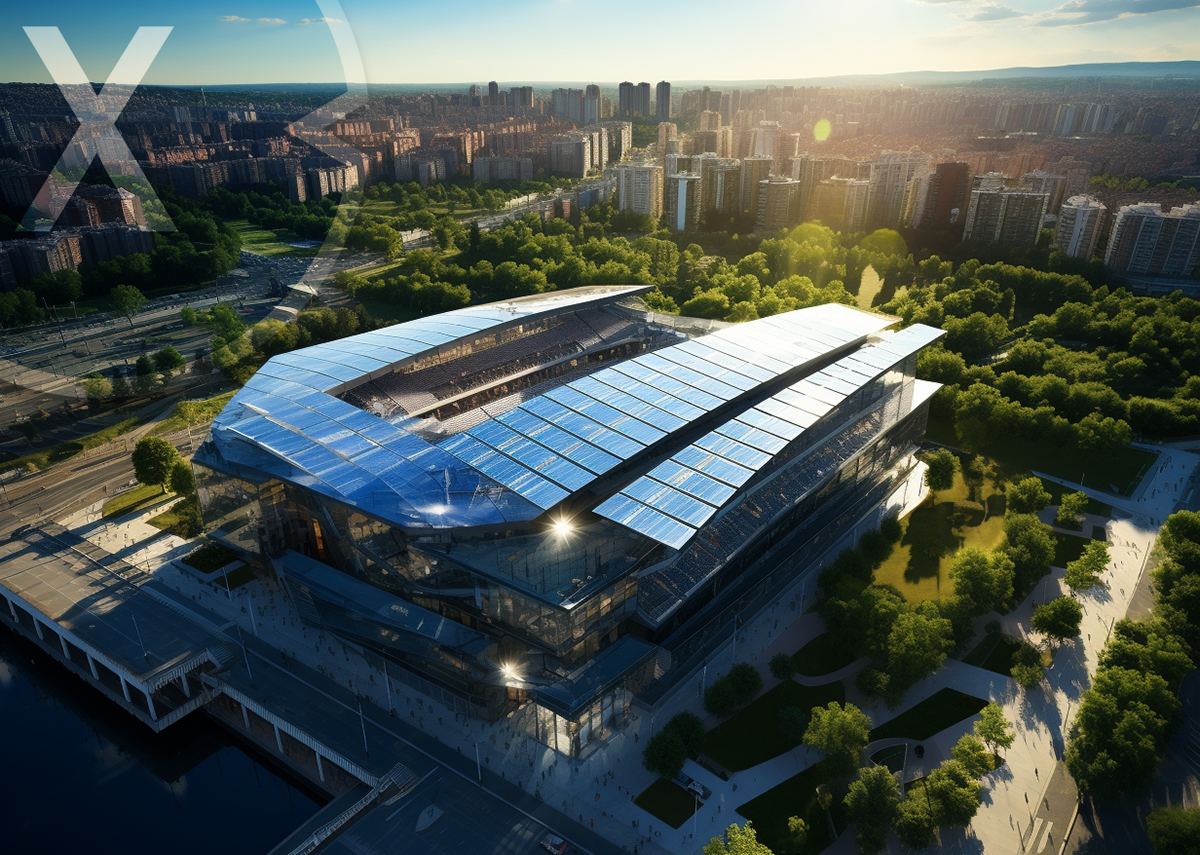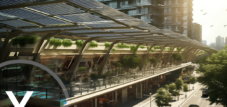
AI & XR 3D Rendering Machine: Energy with transparency – From the facade to the parking lot – Transparent solar modules – Image: Xpert.Digital
🌞⚡️ For large projects such as solar carports - transparent solar modules: building-integrated photovoltaics in inner cities for an intelligent power grid
In the future, transparent solar modules combined with smart grid technologies could play a central role in ensuring a decentralized and sustainable energy supply in urban areas.
🏙️🌿 The future of GIPV and transparent solar modules
In the future, transparent solar modules combined with smart grid technologies could play a central role in ensuring a decentralized and sustainable energy supply in urban areas. They could become part of an integrated system that combines energy production, storage and management to respond to the dynamic demands of urban life.
Suitable for:
🏢🌞 GIPV and BIPV: fusion of architecture and solar energy
GIPV represents an innovative and aesthetically pleasing approach to generating renewable energy in urban areas. GIPV systems are not only sources of energy, but also elements of the construction process as they are integrated directly into the building envelope. Transparent solar modules open up new possibilities for architects and urban planners, especially in inner cities, where space for conventional solar modules is often limited.
🤝💡 Integration of photovoltaics into building structures
Both abbreviations refer to the integration of photovoltaic or solar modules into the building architecture. Solar panels are integrated into the building shell or other components to generate renewable energy without affecting the aesthetic design of the building.
- GIPV: Building-integrated photovoltaics
- BIPV: Building-integrated photovoltaics / building-integrated photovoltaics
🌱🏗️ Towards a sustainable and energy efficient future
The implementation of GIPV, especially in the form of transparent solar modules, is therefore a step towards a more sustainable and energy efficient future, in which the boundaries between buildings and energy producers are blurred and our cities become not only living and working spaces, but also active energy producers.
🌟🌱 The advantages of GIPV
The advantages of GIPV, especially with transparent solar modules, are many:
🖼️ 1. Aesthetics
The GIPV systems fit seamlessly into the cityscape and increase the visual appeal of buildings with their modern aesthetics.
🔋 2. Energy efficiency
Transparent solar modules reduce the need for traditionally generated energy and support the reduction of CO2 emissions.
💰 3. Economy
By combining construction functions and energy production, significant cost savings can be achieved.
✨ 4. Flexibility
Transparent solar panels can be manufactured in different sizes and shapes, allowing their application in different types of buildings.
🏙️ 5. Accessibility
GIPV makes the use of solar energy possible even in densely built-up inner cities, a decisive advantage in areas with limited space.
🌞⚙️ Challenges and solutions
Despite the obvious advantages, there are also challenges that must be overcome:
🔍 1. Cost effectiveness
The initial investment is often higher than with conventional solar modules.
💡 2. Technological development
The efficiency of transparent solar modules must be further increased in order to outperform conventional systems.
🚧 3. Regulatory hurdles
Building and monument protection regulations can make the installation of GIPV systems more difficult.
📣 Similar topics
- 🌞 Outlook for building-integrated photovoltaics
- Energy innovation in urban planning
- 🔆 Integrated energy systems
- ⚡ Future of urban architecture
- 🌆 Urban sustainability
- 🔋 Innovative energy management
- 🌄 From aesthetics to efficiency
- 🌍 Sustainable energy production
- 🌞 Photovoltaic integration in buildings
- 🏙️ Energy in the city landscape
#️⃣ Hashtags: #RenewableEnergy #CityPlanning #Sustainability #SmartGrid #BuildingintegratedPhotovoltaics
➡️ In order to overcome these hurdles, close cooperation between urban planners, architects, builders and the solar industry is necessary. Government funding and incentives could also help accelerate the introduction of GIPV systems.
⚡🔋 Building a smart power grid
🌍 An intelligent power grid integrates all actors into an overall system through the interaction of generation, storage, network management and consumption. Power plants (including storage) are already controlled in such a way that the same amount of electrical energy is always produced as is consumed. Intelligent power grids include consumers as well as decentralized small energy suppliers and storage devices in this control, so that, on the one hand, consumption is balanced in time and space (smart power/intelligent power consumption) and, on the other hand, non-disposable generation systems (e.g. wind energy and PV Systems) and consumers (e.g. lighting) can be better integrated.
🔄 Due to the larger share of renewable energies, it is becoming more important to align the fluctuations in energy production with the fluctuations in energy consumption. In addition to the possibility of storing electrical energy using energy storage or storage power plants, demand-based electricity generation, e.g. B. through hydroelectric power plants or bioenergy, the expansion of power grids for rapid distribution over a large area, there is also the possibility of adapting power consumption to the power supply.
💡 “Electricity generation from solar and wind energy systems makes the supply system much more fragmented and weather-dependent than the operation of conventional power plants. In addition, consumption must be based more closely on the electricity supply. The flexibility required for this cannot yet be achieved with the existing infrastructure. A decentralized system can only function through digital processes in real time and automated decisions,” explains Prof. Dr. Clemens Hoffmann, head of Fraunhofer IEE. Hoffmann sees digitalization as the basis for the next steps in the energy transition: “The coordination and decision-making processes of a decentralized renewable energy supply are extremely complex. Only through artificial intelligence will it be possible to connect different systems such as electricity and heat supply as well as mobility via automated decisions on a large scale. By building an ecosystem for cognitive energy systems, we are advancing the applications of AI in the energy sector.”
📣 Similar topics
- 🔋 Future grid: Intelligent power grid and energy flow
- 🌬️ Controlling wind and sun: flexibility in the smart power grid
- 🌞 Solar power in the intelligent grid: integration and optimization
- 💾 Digitalization as a driver of the energy revolution
- 🔌 Adjust consumption: The role of AI in smart grids
- 🌍 Decentralized energy solutions for climate protection
- 💡 Intelligent energy management through automated decisions
- 🔄 From storage to consumption: The smart energy ecosystem
- 📈 Cognitive energy systems: The next stage of the energy transition
- 💻 Digitally networked: The future of decentralized energy supply
#️⃣ Hashtags: #SmartGrid #RenewableEnergy #EnergyDigitalization #CognitiveEnergySystems #EnergyTransition
🏢🌞 BIPV / GIPV: Building-integrated photovoltaics with partially transparent solar modules – Building-integrated photovoltaics 🌍🌆
Building-integrated photovoltaics with partially transparent solar modules is an attractive option for the construction of energy-efficient buildings. This technology can help reduce energy supply costs while improving the exterior of the building.
More about it here:
The Xpert.Solar solar carport planner
Solar parking spaces are a promising way to generate renewable energy while optimizing limited space requirements in cities and urban areas. However, there are actually some challenges that can complicate the introduction of such parking spaces.
One of the biggest hurdles is the high cost and planning effort associated with installing solar panels in parking lots. Not only must the cost of the solar panels themselves be taken into account, but also the cost of the infrastructure required to connect the panels to the grid. In addition, the space required for installing the solar modules must be precisely planned and coordinated to ensure effective use of the available space.
Another obstacle are bureaucratic hurdles and approval processes that can make it difficult to install solar panels in parking lots. Depending on the region or country, different rules and regulations may apply, which can complicate the approval and implementation process.
Despite these challenges, there is high demand for solar parking spaces as they represent an effective way to promote renewable energy while optimizing space requirements in urban areas. With careful planning and collaboration between the parties involved, the hurdles can be overcome to facilitate the introduction of such parking spaces.
➡️ We specialize in providing advisory and planning support for such solar carport projects and advancing their implementation.
➡️ With our solar carport planner we simplify the process.
➡️ We are there for you for the next steps and thus minimize costs and effort for you.
More about it here:
We are there for you - advice - planning - implementation - project management
☑️ From simple solar carports to large parking spaces
☑️ Your individual photovoltaic parking space advice with Xpert.Solar
Xpert.Solar is your ideal partner for the planning, consulting and construction implementation of ground-mounted photovoltaic systems and agricultural photovoltaic projects due to our many years of experience and expertise in the solar energy industry. Xpert.Solar has an experienced team of professionals that offers tailored solutions to farmers and investors. From location analysis to financial and legal advice to technical implementation and monitoring, Xpert.Solar supports its customers professionally and reliably to ensure successful and sustainable implementation.
I would be happy to serve as your personal advisor.
You can contact me by filling out the contact form below or simply call me on +49 89 89 674 804 (Munich) .
I'm looking forward to our joint project.
Xpert.Digital - Konrad Wolfenstein
Xpert.Digital is a hub for industry with a focus on digitalization, mechanical engineering, logistics/intralogistics and photovoltaics.
With our 360° business development solution, we support well-known companies from new business to after sales.
Market intelligence, smarketing, marketing automation, content development, PR, mail campaigns, personalized social media and lead nurturing are part of our digital tools.
You can find out more at: www.xpert.digital - www.xpert.solar - www.xpert.plus
Industrial & B2B Business Metaverse: Reduce costs with XR technology for photorealistic product images (XR 3D rendering machine)
XR technology offers a superior solution for creating photorealistic images and allows companies to free themselves from the expensive fees of external media agencies. It is common knowledge that media agencies charge high costs to create such images as it requires expertise, special software and collaboration with various experts.
More about it here:

